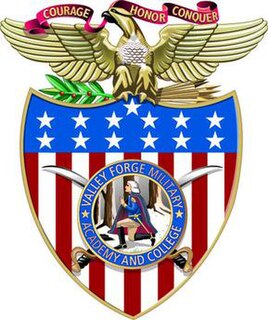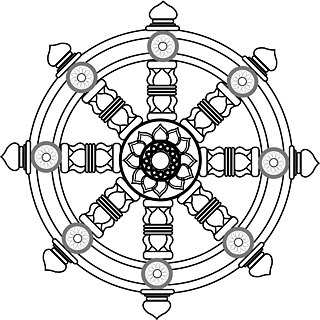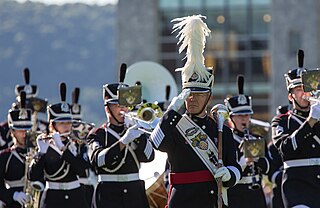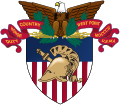
The United States Military Academy (USMA), also known metonymically as West Point or simply as Army, is a United States service academy in West Point, New York. It was originally established as a fort, since it sits on strategic high ground overlooking the Hudson River with a scenic view, 50 miles (80 km) north of New York City. It is the oldest of the five American service academies and educates cadets for commissioning into the United States Army.

The Royal Military Academy Sandhurst, commonly known simply as Sandhurst, is one of several military academies of the United Kingdom and is the British Army's initial officer training centre. It is located in the town of Sandhurst, Berkshire, though its ceremonial entrance is in Camberley, Surrey, southwest of London. The academy's stated aim is to be "the national centre of excellence for leadership". All British Army officers, including late-entry officers who were previously Warrant Officers, as well as other men and women from overseas, are trained at the academy. Sandhurst is the British Army equivalent of the Britannia Royal Naval College and the Royal Air Force College Cranwell.
The United States service academies, also known as the United States military academies, are federal academies for the undergraduate education and training of commissioned officers for the United States Armed Forces.

Valley Forge Military Academy and College (VFMAC) is a private boarding school and military junior college in Wayne, Pennsylvania. It follows in the traditional military school format with army traditions. Though military in tradition and form, the high school portion of VFMAC, Valley Forge Military Academy, is a college-preparatory boarding institution specializing in student leadership. VFMAC's administration is composed almost entirely of current or retired military, and the board of trustees is almost entirely alums. Some graduates pursue careers in the armed services, and VFMAC has graduated one Rhodes Scholarship recipient.
Bill the Goat is the mascot of the United States Naval Academy. The mascot is a live goat and is also represented by a costumed midshipman. There is also a bronze statue of the goat in the north end zone of Navy–Marine Corps Memorial Stadium. This statue also plays a role in "Army Week" traditions.

The United States Military Academy Preparatory School (USMAPS), sometimes referred to as West Point Prep, is a preparatory school for the United States Military Academy (USMA). Located in West Point, New York, its official mission is "to provide academic, military and physical instruction in a moral-ethical military environment to prepare and motivate candidates for success at the United States Military Academy."

The Sandhurst Military Skills Competition is a military skills competition at West Point that first began in 1967 with the presentation of a British officer's sword to the United States Corps of Cadets by the British Exchange Officer. 2010's event, dubbed SANCOM10, was a two-day event conducted at West Point, New York. The 2009 competition featured a record 49 teams and nearly 500 competitors. Besides the 36 squads from each of the West Point companies, visiting service academy teams included the Naval, Air Force and Coast Guard Academies, Britain's Royal Military Academy Sandhurst (RMAS) teams "Red" and "Blue", Australia's Royal Military College Duntroon, Canada's Royal Military College (RMC), the National Military Academy of Afghanistan, and the Chilean Military School. That year saw eight ROTC squads: Texas A&M, BYU, East Carolina University, Iowa State University, Florida Tech, Georgetown, University of Hawaii, and Appalachian State.

The United States Naval Academy Chapel in Annapolis, Maryland, is one of two houses of worship on the grounds of the Navy's service academy. Protestant and Catholic services are held there. The Naval Academy Chapel is a focal point of the Academy and the city of Annapolis. The chapel is an important feature which led to the Academy being designated a National Historic Landmark in 1961.

The Chaplain Corps of the United States Army consists of ordained clergy of multiple faiths who are commissioned Army officers serving as military chaplains as well as enlisted soldiers who serve as assistants. Their purpose is to offer religious church services, counseling, and moral support to the armed forces, whether in peacetime or at war.

The United States Air Force Academy Cadet Chapel, completed in 1962, is the distinguishing feature of the Cadet Area at the United States Air Force Academy north of Colorado Springs. It was designed by Walter Netsch of Skidmore, Owings and Merrill of Chicago. Construction was accomplished by Robert E. McKee, Inc., of Santa Fe, New Mexico. Originally controversial in its design, the Cadet Chapel has become a classic and highly regarded example of modernist architecture. The Cadet Chapel was awarded the American Institute of Architects' National Twenty-five Year Award in 1996 and, as part of the Cadet Area, was named a U.S. National Historic Landmark in 2004.

"The Corps" is a poetic hymn associated with the United States Military Academy. It is second in importance to only the Academy's Alma Mater. The words were written by West Point Chaplain, Bishop H.S. Shipman, around 1902. The accompanying music was composed in 1910 specially for the ceremonial closing of the Old Cadet Chapel and opening of the new Cadet Chapel. "The Corps" was first sung on the steps of the Cadet Chapel on 12 June 1910, and became part of the graduation ceremony starting in 1911. Today, "The Corps" is typically sung by the Cadet Glee Club in companion to the Alma Mater at alumni gatherings, graduation, memorial ceremonies and funerals.

The United States Military Academy and grounds were declared a National Historic Landmark in 1960 due to the Revolutionary War history and the age and historic significance of the academy itself. The majority of the buildings in the central cadet area are historic.
The history of the United States Military Academy can be traced to fortifications constructed on the West Point of the Hudson River during the American Revolutionary War in 1778. Following the war, President Thomas Jefferson signed legislation establishing the United States Military Academy (USMA) on the site in 1802. In 1817 the academy was transformed by the appointment of Sylvanus Thayer who drastically reformed the curriculum.

The Cadet Chapel at the United States Military Academy is a place of Protestant denomination worship for many members of the United States Corps of Cadets. The chapel is a late example of Gothic Revival architecture, with its cross-shaped floor plan, soaring arches, and ornate stone carvings. It houses the largest chapel pipe organ in the world, which consists of 23,511 individual pipes. The Cadet Chapel dominates the skyline and sets the architectural mood of the academy. Designed by architect Bertram Goodhue and completed in 1910, it replaced the neoclassical Old Cadet Chapel which had been built in 1836. The Old Cadet Chapel was deconstructed and relocated to the entrance of the West Point Cemetery, where it stands today.

The Old Cadet Chapel at the United States Military Academy is a church and location of funeral and memorial services. It is the oldest chapel at West Point, having originally been built in 1836. The chapel was originally located in the cadet area near present-day Bartlett Hall, but was disassembled brick-by-brick and moved to the West Point Cemetery when the current Cadet Chapel opened in 1910. Lutheran services are held at the old chapel on Sunday mornings during the school year.

Buddhists make up a small percentage of the United States military, with a 2009 article stating that only 5,287 of 1.4 million military personnel identified themselves as Buddhists.

Religious symbolism in the United States military includes the use of religious symbols for military chaplain insignia, uniforms, emblems, flags, and chapels; symbolic gestures, actions, and words used in military rituals and ceremonies; and religious symbols or designations used in areas such as headstones and markers in national cemeteries, and military ID tags.

The West Point Band is the U.S. Army's oldest active band and the oldest unit at the United States Military Academy, traces its roots to the American Revolutionary War. At that time, fifers and drummers were stationed with companies of minutemen on Constitution Island, across the river from West Point. In 1778, General Samuel Holden Parsons' 1st Connecticut Brigade crossed the Hudson River and established West Point as a permanent military post. After the American Revolution, Congress disbanded most of the Continental Army, but "the 55 men at West Point", members of the 2nd Continental Artillery, remained as they were. Among their ranks stood at least one drummer and one fifer, who alone maintained the tradition of military music at West Point.

Brenda S. "Sue" Fulton is an American government official and former military officer who has served as the assistant secretary of veterans affairs for public and intergovernmental affairs in the United States Department of Veterans Affairs since July 2022. She commissioned in the United States Army as a signal officer, serving as both a platoon leader and company commander in Germany before receiving an honorable discharge at the rank of captain.





















